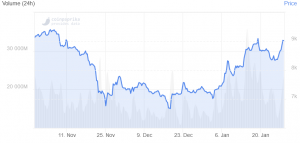Bitcoin Plays With USD 9,000, While Virus Fears Weigh on Stocks
Bitcoin (BTC) is once again trading around USD 9,000, while the risk-off sentiment has hit stock markets across the globe hard in recent days.

At pixel time (10:35 UTC), BTC trades at c. USD 9,010 and is up by 4% in the past 24 hours and the past week. Earlier today, the price reached USD 9,100 before dropping to almost USD 8,900 and moving back to USD 9,000.
Also, while the U.S. S&P 500 stock index has sold off about 2.2% over the past three days, the number one cryptocurrency is up by about 8% over the same time period.
BTC price chart:

Although the exact reason for the most recent surge in bitcoin is still unclear, some commentators point to the Wuhan coronavirus in China as a possible explanation. According to this narrative, the sell-offs in the stock market should be good for bitcoin, assuming – of course – that the digital asset is, in fact, a safe-haven.
However, economist and crypto trader Alex Krüger is skeptical of this virus-related narrative and concluded that “it would seem BTC just did its own thing.”
“Bitcoin’s price did not even flinch when the first coronavirus sell-off started. It is clear BTC did not react to the first panic wave. What did bitcoin do when China stocks sold off again on the 22nd (the 2nd panic wave)? This time BTC moved lower. When stocks crashed on Friday while BTC had a positive day, narrative flipped from “bitcoin positively correlated with stocks” to “bitcoin negatively correlated with stocks.” Although the Friday afternoon reversal must have been troubling for narrative seekers,” he explained.
Bitcoin’s potential safe-haven status was also mentioned in a Bloomberg article on Tuesday, which said that “potential explanations for the rally include bitcoin’s potential new safe-haven status amid risk-off moves fueled by the spread of the virus.”
“Some hedge funds who do not necessarily have a fundamental view on bitcoin direction could see opportunities in trading volatility. The CME’s reputation and credibility in U.S. derivatives markets more broadly could be a substantial advantage in attracting those potential market participants,” JPMorgan Chase & Co.’s Nikolaos Panigirtzoglou was quoted as saying.
Meanwhile, Charlie McElligott of Nomura Securities International, pointed to the fact that U.S. five-year real yields are the most negative since April 2017, “acting as a major bullish catalyst for gold and bitcoin.”
Others, including founder of Real Vision Group, Raoul Pal, focused mostly on the technical picture, saying that “Bitcoin is breaking out of an inverse head and shoulder formation (with a very weak right should which make it often more powerful).”




